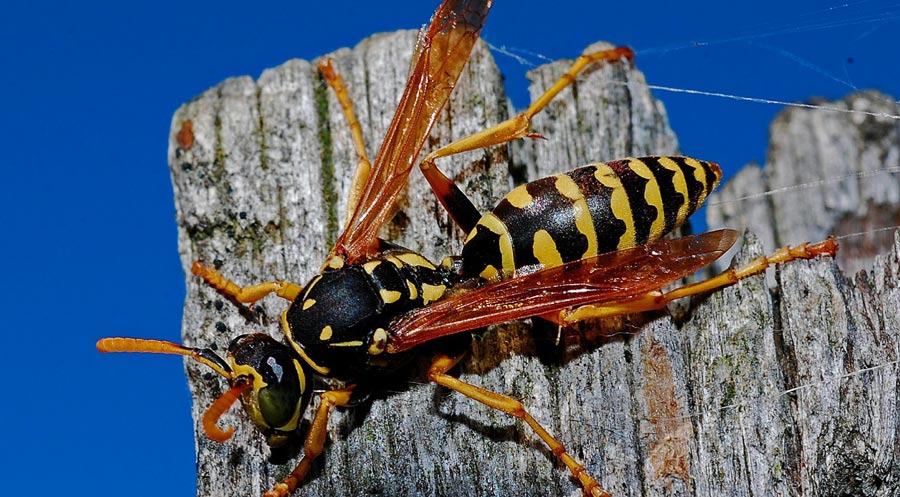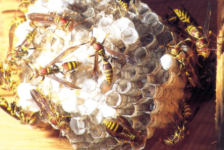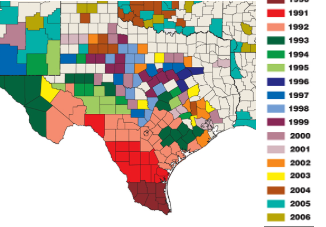
For the most part, these flying insects keep to themselves and will not bother you. However, if you do accidentally disturb one, the result can be painful or even dangerous where several are involved. Also, the nests / hives they build can cause major issues and be hard to find and remove. So wasp control and exterminator services are important to keep in mind.
Differences between wasps and bees:
- Wasps tend to have brighter coloration and patterns than bees
- Wasp bodies are smoother while bees tend to be more hairy.
- Due to their hairless bodies, wasps do not carry pollen. They do feed on nectar and collect other insects to feed to their carnivorous young.
- Wasps can sting repeatedly, as opposed to some bees that lose their stinger once it is used.
Wasp Exterminator:
Several kinds of stinging wasps can pose serious health and safety threats to humans. Most problems occur when people are stung after getting too close to wasp nests constructed near homes, buildings and recreational areas. In such situations, it may be necessary to control the wasps, even though most wasps are beneficial pollinators and predators of other insects.
Although thousands of North American wasp species can sting few are potentially dangerous to humans. Of the fewer than 40 species of stinging (vespid) wasps that occur in the United States, only a handful are important stinging pests in Texas.
Wasps found in Texas:
- Paper Wasps
- Yellow jackets
- Hornets
- Cicada Killers
- Mud Daubers
- Mexican Honey Wasps

Bee Control, not Bee exterminator
Bees are very important for all of us to survive. Honey bees not only provide honey and wax, but, as pollinators, are of far greater importance. Nearly all the food we eat relies on them as pollinators. Other Bees may not even have stingers and provide vital pollination for native flowers and vegetables. Many of these don’t live in a nest, but only are interested in building a single gallery where the female lays an egg on a cache of nectar and pollen for her future young larvae. Control of these gentle, beneficial pollinators is often not needed!
Bees of Texas
- Honey Bees
- Bumble Bees
- Large Carpenter Bees
- Small Carpenter Bees (tiny dark)
- Hairy-legged (digger, miner, chimney, longhorn)
- Striped Hairy Belly Bee (leafcutter, carders )
- Metallic Hairy Belly Bee (masons)
- Green Sweat Bees (metallic green)
- Striped Sweat Bees & Tiny Dark Bees
- Cuckoo Bees
- Striped Abdomen (mining) Bees
- Striped Abdomen (plasterer) Bees
- Striped Abdomen (oil-collecting Bees)
Click on below link to see a Bees of Central Texas General Guide with Pictures
https://tpwd.texas.gov/education/bioblitz/160829_jha_lab_bee_guide.pdf
Africanized Honey Bees (AHB) (AKA – Killer Bees)
If you live in an area known to have AHBs or are within 100 miles of such an area (they are advancing at a rate of up to 100 miles each year), it is not advisable to approach a colony, hive, or swarm of honey bees without first putting on a complete bee suit. Likewise, it is not advisable to get within 100 feet (30 m) of an AHB colony, hive, or swarm unless fully suited up.

There is a giant nest in my yard!!!!
We get this a lot and it’s almost always a swarm. With literally thousands of bees in the air, swarms may appear dangerous, but don[‘t call the exterminator just yet. In fact, they pose little threat. Eventually the swarm will land and remain clustered in one place for a few hours or several days. During that time, scout bees are looking for a suitable nesting site. Once the scouts find a new nest site and communicates its location to the swarm, the bees will move on to their new home.
 A honey bee swarm. (Photo courtesy of B. Pierson)
A honey bee swarm. (Photo courtesy of B. Pierson)
If a swarm lands in a remote site, it should be left alone. Because swarms do not have a nest to defend, do not contain stored food or immature bees and the bees in the swarm are often full of honey, swarming bees are usually more docile than established colonies and less likely to sting. However, there is always a risk when working around bees.
Swarms that land near buildings or high traffic areas should be managed. Bees may try to nest in wall voids or floors of buildings if they can gain entry. It’s much easier (and less costly) to have a company come remove a swarm from a tree than a hive from your wall. The presence of a swarm may also indicate that a colony is nearby. Newly formed swarms tend to gather near their former nesting site for a short while after emerging. You should scan the area carefully to determine if there is a colony nearby that should be controlled.
Avoiding a sting:
Wasps and bees are instinctively attracted to the upper bodies of animals, so in the event of an attack it is best to cover your head and run away quickly.
The best defense is to run to a building, car or other protected place. Victims who stand in place and attempt to swat their attackers will continue to receive stings as the wasps summon reinforcements via chemical communication. Unlike honeybees, wasps do not leave a stinger in the skin and may sting repeatedly.
If attacked by bees, you should cover your face and move out of the bees’ territory as fast as possible. European bees usually defend an area within 100 yards of the colony, while Africanized bees will defend an area within 400 yards of the colony. Taking shelter in a car or house is often the best strategy, even though a few bees may follow. Do not try to trick the bees by hiding or playing dead because they will continue the attack as long as you are within their territory. If you see someone else being attacked, do not attempt to keep the bees off of the victim with a water hose.
Once away from the attack, remove the stingers as soon as possible. Stingers should be scraped out with a fingernail, knife or some other sharp object. Stingers continue to inject venom for many minutes after the initial sting. The sooner a stinger is removed, the less venom will be injected. If you experience hives, difficulty breathing, or other signs of an allergic reaction, you should seek medical attention immediately.
What if you’re stung?
- Wash the area quickly with soap and water to remove as much venom as possible.
- Apply a cold pack to reduce swelling and pain.
- Keep the wound clean and dry
- Cover with a bandage if desired.
Any of the below symptoms could indicate an anaphylaxis response due to a severe allergic reaction and you should immediately seek medical attention:
- Severe swelling of the face, lips or throat
- Hives or itching in areas of the body not affected by the sting
- Breathing difficulties, such as wheezing or gasping
- Dizziness
- Sudden drop in blood pressure
- Lightheadedness
- Loss of consciousness
- Nausea or vomiting
- Diarrhea
- Stomach cramps
- Weak or racing pulse
How do we prevent and get rid of these bugs?
Prevention:
- Search for entry points into your home and patch them. Paper wasps and bees like to build nests in the walls of your home. It’s extremely important to prevent them from entering. Block all holes where pipes and wiring enter, cracks in window framing, knot holes in wood siding, weep holes in bricks, and cracks where wood and brick join. Most of these holes can be filled with caulking, but holes necessary for air flow should be blocked with wire screen. The screen mesh should be less than 1/8 inch. Chimneys should be properly capped. Make it difficult to get in.
- Have airtight lids for your garbage cans. Wasps like to forage for food in trash. If it’s easily accessible, they will be more likely to build a nest.
- Place wasp nest decoys around your home. These are available on Amazon. Wasps avoid other wasp nests, so these trick them to stay away.
- Non-scientific methods:
- Oils – There are theories that if you mix peppermint oil with water and spray your eaves – wasps will stay away. The same goes for a combination of clove, geranium and lemongrass essential oils. https://www.ncbi.nlm.nih.gov/pubmed/23081867
- Paint your ceiling, shutters and window panes a haint blue color. This is a remedy based on very old folklore. The theory is that the blue tricks the insects into thinking the ceiling is the sky and so they do not build a next. It also keeps evil spirits away. There is no science there. However, back when it was begun, the paint contained lime which was an insect repellent. Many swear by this, but realist say its hogwash. Either way – it’s pretty!
Treatment:
- Wasp nests need to be sprayed and the wasps killed. It is best to do this at night when the workers and queen are all at the nest. Then the nest needs to be removed. If there is a single nest, you might feel comfortable doing this yourself using a wasp and hornet killer bought at the store. If the nest is large or there are so many wasps that you suspect there is more than one nest, give the exterminator a chance to take care of it for you. If you see hornets (small wasps) coming out of the ground, we highly recommend you call in professionals. Hornets are mean and underground nests are very hard to treat using those chemicals available at a grocery store.
- It is our preference to assure that live bee removal and relocation is used to move the bees from your premises. However, aside from the potential of being stung (which is not high) having a beehive in your home is a major concern. Even Honeybee hives that are relatively gentle may be considered pests when they build hives in and around structures or anywhere humans frequent. In houses & sheds, hives can weigh hundreds of pounds, containing honey, wax, bee brood (baby bees:eggs-larvae-pupae). Hives also attract other pests including: Cockroaches, beetles, moths, ants, spiders, maggots and Rodents.
- Don’t Spray a Beehive! A dead beehive will quickly decompose, attracting loads of pests, resulting in a very foul smelly mess. Maggots crawl away from the nest and spread throughout the building. Honey decomposes and drips, creating an ugly, dark, sticky mess. Bees from nearby hives are attracted and often are very aggressive, stinging people & pets. Once bees are removed, the hive and all remaining ‘evidence’ of the hive must be removed. This includes opening up the wall, cleaning out the mess, often replacing insulation and sheetrock. It’s a big job and we highly recommend you allow a professional to do it.
- Honey bees that have moved into a structure should be relocated and the nest removed as quickly as possible. The longer you delay, the more difficult the job will be.


